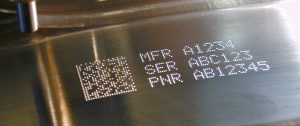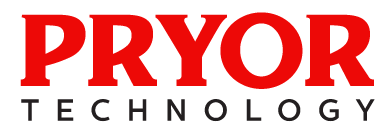
JES 131 is a Rolls-Royce specification that defines and controls methods and requirements for the marking and identifications of components. In simple words it defines what should be marked on Rolls-Royce components.
JES stands for Joint Engineering Standards. The JES 131 specification covers human readable and 1D / 2D machine readable part marking processes.
- Human readable marks are typically letters and numbers. For example, a serial number.
- 1D machine readable codes are what is typically thought of as a bar code. They will store numbers in a code that is 1 dimensional – typically vertical lines of varying thickness and pattern.
- 2D machine readable codes are more complex and encode numbers and letters into a shape. QR codes are the most famous example but industrial applications tend to use a Data Matrix code.
JES 131 is essentially a UK / European Rolls-Royce specification which has now been combined with other Rolls-Royce specifications and has been rewritten into a Rolls-Royce global specification RRES 90003. However, many component definitions (drawings) will still instruct part marking to a JES 131 dash number call out. The specification has not been withdrawn.
Marking Methods
The specification covers all forms for marking methods, ranging from traditional methods of press and roll marking right through to modern computer controller marking machines.
How Do I Use JES 131
Item identification can initially be broken down into 2 pieces of information for the manufacturer:
- Where do I mark the part?
- What method(s) are permitted for marking the part
The component definition will specify both of the above as a minimum. It is normal for the area permitted for marking to be shown by an arrow and a short note. The note will state what method(s) of marking are permitted in the form of a specification designation. The spec. designation can then be looked up in a spec. table usually found on sheet 1.
The component definition spec. table will instruct the only marking methods that are permitted on the part. No other part marking methods are permitted.
The component definition dash call out can then be looked up in the current revision of JES 131. This is where the part method can then be examined further.
At this point more information can be understood about:
- Marking Method
- What information to mark
- Some important do’s and don’ts
Information to Mark
Typically, for a serialised part the following information is required:
MFR – This is a CAGE code identification
SER – This is the actual serial number. NOTE – The format of the serial number is important but is not instructed through JES 131 (see appropriate serialisation specification)
PNR – This is the Part Number specified on the component definition
For a non-serialised part, the following is typically required to be marked
MFR – As above
PNR – As above
Please note, other information may be required to be marked and this would normally be instructed from the component definition.
Machine Readable Marking
Extensive information can be found about the machine-readable marking requirements. The specification also covers:
- Exemptions that can be granted
- Machine Readable marking on painted items
- Approved part marking readers
- Bags, tags and labels
Key Points
- The component definition instructs the method of marking and the position of marking. No other options are permitted without Rolls-Royce Engineering approval.
- JES 131 instructs the data content required for serialised and non-serialised part marking. Other information may be required – check the component definition.
- Human readable part marking must be legible without magnification.
- Cancellation of a human readable part mark is by single line strike out. Machine readable identification (2D) has a different technique.
- Machine readable identification is instructed through JES 131 on all parts unless the component definition instructions are different. However, exemptions are permitted and these are provided in JES 131.
- Abbreviated marking is permitted for parts with limited space requirements.
- Unspecified marking (marks not instructed by component definition or JES 131) are permitted under certain conditions.
- Laser marking is only permitted when instructed by component definition. Laser marking is also subject to additional material process requirements.
- Options for part marking painted parts are contained in JES 131.
- Final quality acceptance for part marking shall be met after all manufacturing processes are completed. Where machine readable marks are applied then these shall be read with a Rolls-Royce approved reading device.
- Where the component definition does not specify the CAGE to be marked then refer to JES 131 look up tables.
Help in Implementing
Pryor engineers have worked closely with JES 131 and have extensive knowledge of all aspects of the document. Get in touch for further advice about marking methods or the specification in general.
Pryor quality control software has been designed around the standard’s requirements and has simple functions built in to it for key areas, such as monitoring the marking process for declining quality.

2 Comments “What Is JES 131?”